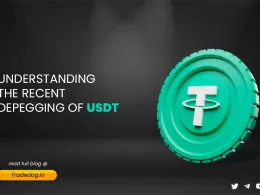Quick Links
Welcome to the exciting realm of cryptocurrency trading! This guide is essential for both experienced traders and newcomers. It’s vital to grasp the concepts of taking long and short positions to maneuver through the crypto markets effectively. Keep in mind that trading in cryptocurrencies carries substantial risks, so it’s essential to make well-informed decisions.
Understanding the Basics
Long and short positions are fundamental concepts in crypto trading, mirroring strategies used in traditional stock markets but with distinct nuances due to the inherent volatility of the crypto market.
A long position is initiated when a trader buys a cryptocurrency, anticipating that its price will rise in the future. The goal here is straightforward: purchase now at a lower price and sell later at a higher price to earn a profit. This approach is typically fueled by a bullish outlook on the market, where the trader believes that the cryptocurrency’s value will appreciate over time.
On the other hand, a short position is taken when a trader speculates that the price of a cryptocurrency will decline. This involves borrowing a cryptocurrency and selling it at the current market price. The trader aims to repurchase the same amount of the cryptocurrency later, but at a lower price, return the borrowed amount, and pocket the difference as profit. Short selling is a more complex strategy and reflects a bearish sentiment on the market.
In crypto trading, these strategies are particularly significant due to the market’s high volatility. Cryptocurrency prices can experience rapid and effective fluctuations, offering the potential for substantial profits but also posing considerable risks. This volatility can be attributed to various factors like regulatory news, technological advancements, market sentiment, and liquidity levels. As a result, traders often need to be more agile and informed, constantly monitoring market conditions to make timely decisions. Both long and short positions in crypto trading require not only an understanding of market trends and behaviours but also a readiness to respond to sudden changes in market conditions.
Strategy for Long Positions
In crypto trading, taking a long position involves purchasing a cryptocurrency with the expectation that its value will rise, leading to a profit upon selling. Successful long-position strategies often combine various approaches. Here are some strategies for effectively managing long positions in crypto trading, along with an illustrative example:
- Fundamental Analysis: This involves analyzing the intrinsic value of a cryptocurrency by looking at the underlying factors and technologies, the team behind the project, market trends, and news events. For instance, a trader might analyze Bitcoin’s potential based on its growing acceptance as a digital store of value and its limited supply.
- Technical Analysis: Traders use various tools and indicators like moving averages, RSI (Relative Strength Index), and Fibonacci retracement levels to predict future price movements based on historical data. For example, if Bitcoin shows a consistent upward trend on moving average indicators, a trader might decide to take a long position.
- Dollar-Cost Averaging (DCA): This strategy involves regularly purchasing a fixed dollar amount of a cryptocurrency, regardless of its price, reducing the impact of volatility. For example, investing $100 in Ethereum every month, irrespective of its price.
- Hedging: Some traders hedge their long positions by simultaneously holding positions in related assets or derivatives to offset potential losses. For instance, having a long position in Ethereum while also trading Ethereum futures contracts.
- Stop Loss and Take Profit Orders: Setting stop loss and take profit orders can limit losses and secure profits at predetermined price levels. For example, a trader might buy Bitcoin at $20,000, set a stop loss at $18,000 to minimize potential losses, and take a profit at $25,000 to ensure profits are realized.
For example, consider a trader who decides to take a long position in Litecoin (LTC) after assessing its faster transaction speeds and lower fees compared to Bitcoin. They purchase LTC at $150, expecting a price increase. As Litecoin’s adoption grows over the ensuing months, its value escalates to $200, allowing the trader to sell at a profit. This scenario exemplifies how blending fundamental analysis with market trend observations can lead to successful long positions. However, the volatile nature of the crypto market necessitates robust risk management strategies, such as stop-loss orders, to safeguard investments against sudden and unpredictable market shifts.
Risk Management in Long Positions
In managing risks for a long position in cryptocurrency trading, five key risk factors stand out:
- Set Stop Loss Orders: A stop loss order is an essential tool for limiting potential losses. It automatically sells the cryptocurrency if its price falls to a predetermined level. For instance, if you buy Bitcoin at $30,000, you might set a stop loss at $27,000, ensuring that you won’t lose more than 10% of your investment.
- Diversification: Diversification, on the other hand, is a strategy to spread investment risk across various assets. In the context of cryptocurrency trading, this means not investing all capital in a single cryptocurrency but spreading it across different digital currencies and possibly other asset classes like stocks, bonds, or commodities. Diversification reduces the impact of a price decline in any single asset on the overall portfolio.
- Market Volatility: Cryptocurrency markets are notoriously volatile. Prices can swing dramatically in a short period, due to factors like market sentiment, news, regulatory announcements, and technological developments. This volatility can lead to large, rapid changes in the value of cryptocurrencies, impacting long positions significantly. Traders need to be prepared for sudden market movements and have strategies in place to manage these risks, like setting stop-loss orders to limit potential losses.
- Regulatory Risk: The regulatory environment for cryptocurrencies is still evolving globally. Changes in regulations can have a substantial impact on the crypto market. For instance, a country imposing strict regulations or outright banning cryptocurrencies can lead to a significant drop in prices. Staying informed about regulatory changes and understanding how they might affect different cryptocurrencies is crucial for managing this risk.
- Liquidity Risk: Liquidity refers to how easily a cryptocurrency can be bought or sold in the market without affecting its price. Some cryptocurrencies, especially lesser-known or newer ones, may have lower liquidity, making it difficult to exit a position without affecting the price negatively. In a rapidly falling market, this can lead to substantial losses if the trader is unable to sell their holdings quickly. Diversifying investments and focusing on cryptocurrencies with higher liquidity can help mitigate this risk.
Strategy for Short Positions
Short selling in crypto trading is a strategy used to profit from a cryptocurrency’s price decline. It involves borrowing a cryptocurrency, selling it at the current market price, and then repurchasing it later at a lower price to return to the lender, pocketing the difference as profit. Here are some strategies for managing short positions in crypto trading, accompanied by an example:
- Technical Analysis: Traders use technical indicators to identify potential downtrends in a cryptocurrency’s price. Tools like moving averages, RSI (Relative Strength Index), and Bollinger Bands can signal when crypto is overbought and possibly due for a price correction.
- Fundamental Analysis: This involves evaluating the underlying factors of a cryptocurrency that might negatively affect its price. Factors like unfavourable regulatory news, security issues, or problems within the development team can be triggers for a price drop.
- News and Event Trading: Short sellers often capitalize on negative news or events that are likely to impact a cryptocurrency’s price negatively. This includes regulatory crackdowns, security breaches, or negative publicity.
- Candlestick Charts: These charts are crucial for traders to understand price movements. Each candlestick represents price action within a specific time frame (like one hour, one day, etc.) and shows the opening, closing, high, and low prices. Candlestick patterns, such as bearish engulfing or shooting star, can indicate potential reversals or continuation of trends.
- Volume Indicator: The volume of trades is a significant indicator of the strength behind price movements. A price drop with high volume indicates intense selling pressure, reinforcing a potential short position. Conversely, a price drop on low volume might suggest less conviction, indicating the downtrend may not be as strong. Therefore, confirming a potential short position with a high volume can add confidence to the trade.
Risk Management in Short Positions
In the context of short selling in cryptocurrency trading, the following key risk factors stand out:
- Hedging: A hedging strategy can be an effective way to mitigate risk. Hedging involves taking an offsetting or protective position to balance any potential losses from the main position. For instance, if a trader has a short position in a particular cryptocurrency, they might hedge by taking a long position in a related asset. This could be another cryptocurrency that has a historical inverse correlation or a derivative like a futures contract that gains value when the cryptocurrency decreases.
- Leverage Risk: Short selling often involves the use of leverage, meaning traders borrow capital to amplify their trades. While leverage can increase potential profits, it also magnifies losses, especially in a market as volatile as cryptocurrencies. A slight price movement in the wrong direction can result in substantial losses, possibly even exceeding the initial investment. Traders must be cautious with leverage, using it judiciously and understanding the full extent of the risk involved.
- Market Volatility: Cryptocurrencies are known for their high volatility, with prices capable of making substantial moves in very short periods. This volatility can work against short sellers; for example, if a cryptocurrency unexpectedly surges in value due to positive news or market sentiment, it can lead to significant losses. Managing this risk involves setting strict stop-loss orders to limit potential losses and closely monitoring market trends and news that could trigger sudden price movements.
- Regulatory Risk: The crypto market is still in a relatively nascent stage, and regulatory stances in various countries can change rapidly. New regulations or changes in existing policies can significantly affect cryptocurrency prices. For instance, if a significant economy announces a crackdown on cryptocurrencies, it could lead to a sudden increase in prices as traders rush to buy back and cover their short positions. Staying informed about regulatory developments and being prepared to respond quickly is crucial for managing this risk.
Common Mistakes to Avoid
In cryptocurrency trading, avoiding certain common mistakes is crucial for preserving capital and achieving long-term success. Here are five key mistakes that traders, especially those new to the crypto market, should be cautious of:
- Over-Leveraging: Leverage can be a double-edged sword. While it can significantly increase potential profits, it also magnifies potential losses.
- Ignoring Risk Management: Not employing proper risk management strategies like setting stop-loss orders is a common error. Risk management is essential in trading, especially in an unpredictable market like cryptocurrencies.
- Failure to Diversify: Putting all funds into a single cryptocurrency or not diversifying across different types of assets increases risk. The crypto market is unpredictable, and investing heavily in one coin can lead to significant losses if that particular market crashes. Diversification helps in spreading risk and reducing the impact of a poor performance of a single asset.
- Emotional Trading: Many traders make the mistake of letting emotions drive their trading decisions. Fear of missing out (FOMO) can lead to buying at peaks, while panic selling during downturns can result in selling at lows.
- Neglecting Security Measures: With the rise of cyber threats in the crypto space, neglecting security can be costly. Traders often underestimate the importance of securing their crypto assets. Failing to use secure wallets, not enabling two-factor authentication, and using unsecured internet connections can lead to the theft of funds.
Being aware of and actively avoiding these mistakes can greatly improve a trader’s chances of success in the crypto market. It involves being disciplined, strategic, and informed, with a strong emphasis on security and risk management.
Conclusion
In conclusion, successfully navigating the world of cryptocurrency trading requires a comprehensive understanding of long and short positions, alongside effective strategies and tools for managing these positions. Traders must balance the use of technical and fundamental analysis, remain vigilant of market volatility and regulatory changes, and employ robust risk management techniques like stop-loss orders and diversification. The use of advanced trading platforms, portfolio trackers, and secure wallets is crucial for effective trading and security. Moreover, traders should be cautious of common pitfalls such as over-leveraging, emotional trading, and neglecting security measures. By combining these approaches and maintaining discipline and continuous learning, traders can better position themselves to capitalize on the opportunities presented by the dynamic and challenging cryptocurrency markets.









